【Springboot】SpringBoot基础知识及整合Thymeleaf模板引擎
文章目录
-
- SpringBoot简介
-
-
- SpringBoot是什么
- 为什么要学习SpringBoot
- SpringBoot的优势
- 学习SpringBoot前要具备的基础
-
- 创建第一个SpringBoot项目
-
-
- 在Spring官方下创建SpringBoot项目
- 使用IDEA创建SpringBoot项目
-
- SpringBoot配置文件详解
-
-
- 属性配置
- 配置文件分类
-
- SpringBoot整合Thymeleaf模板引擎
-
-
- Thymeleaf简介
- 整合
-
- 总结
博客x主页:己不由心王道长!
文章说明:spring
✅系列专栏:spring
本篇内容:对SpringBoot进行一个入门学习及对Thymeleaf模板引擎进行整合(对所需知识点进行选择阅读呀~)
☕️每日一语:在人生的道路上,即使一切都失去了,只要一息尚存,你就没有丝毫理由绝望。因为失去的一切,又可能在新的层次上复得。☕️
作者详情:作者是一名双非大三在校生,喜欢Java,欢迎大家探讨学习,喜欢的话请给博主一个三连鼓励。
交流社区:己不由心王道长(优质编程社区)
SpringBoot简介
SpringBoot是什么
①Spring Boot是由Pivotal团队提供的全新框架,其设计目的是用来简化新Spring应用的初始搭建以及开发过程。该框架使用了特定的方式来进行配置,从而使开发人员不再需要定义样板化的配置。通过这种方式,Spring Boot致力于在蓬勃发展的快速应用开发领域(rapid application development)成为领导者。

为什么要学习SpringBoot
一、SpringBoot能简化配置、从 2002 年开始,Spring 一直在飞速的发展,如今已经成为了在Java EE(Java Enterprise Edition)开发中真正意义上的标准,但是随着技术的发展,Java EE使用 Spring 逐渐变得笨重起来,大量的 XML 文件存在于项目之中。
SpringBoot的优势
1、减少开发,测试时间和努力。
2、使用JavaConfig有助于避免使用XML。
3、避免大量的Maven导入和各种版本冲突。
4、提供意见发展方法。
5、通过提供默认值快速开始开发。
6、没有单独的Web服务器需要。这意味着你不再需要启动Tomcat,Glassfish或其他任何东西。
学习SpringBoot前要具备的基础
声明:这不是在劝退,而是在告诉同志们,学习是一个循序渐进的过程,不可操之过急。一步一个脚印的走,才能到达终点站。
学习这个知识点你应该具备的一些基础知识:
基础篇:javase基础,包括但不限于:面向对象,封装,继承,多态,类与接口,集合,IO等等。
基础篇:Spring、SpringMVC:知道Spring是用来管理bean,能够基于Restful实现页面请求交互功能
基础篇:熟练掌握Mybatis
创建第一个SpringBoot项目
在Spring官方下创建SpringBoot项目
一、打开Spring官方—>projects—>SpringBoot—>Spring initializr;
或者点击创建SpringBoot看到以下图片:

按照上述图片完成后执行第7步会下载一个压缩包:

二、找到压缩包位置解压
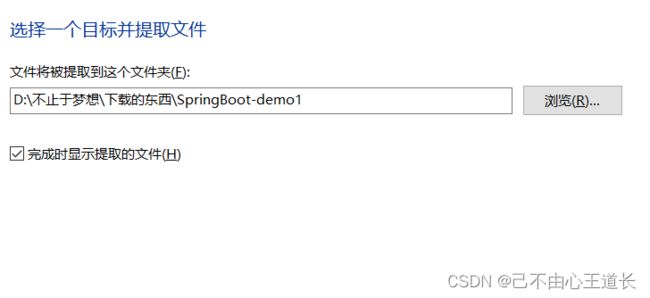
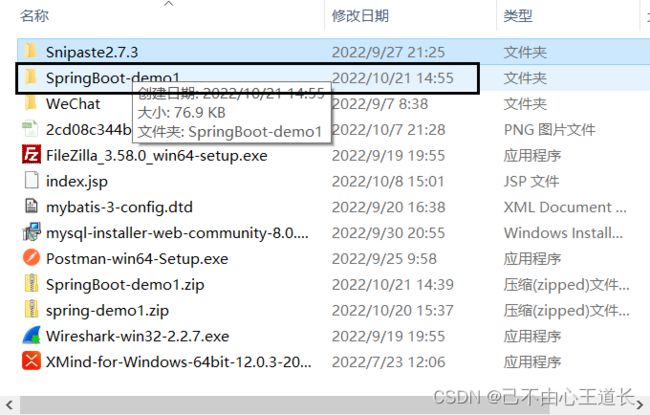
三、导入创建好的SpringBoot项目
打开IEDA:file—>open:找到刚才文件解压位置,加载进来即可

或者直接把解压好的文件拖进IDEA也可以:

如图:
使用IDEA创建SpringBoot项目
说明:我们一般是不会在Spring的官网上创建SpringBoot项目的,而是使用IDEA创建项目,因为IEDA为我们准备好了创建工具,这样的创建更加省时省力。
二、在项目里新建一个modules,取名为SpringBoot-demo1
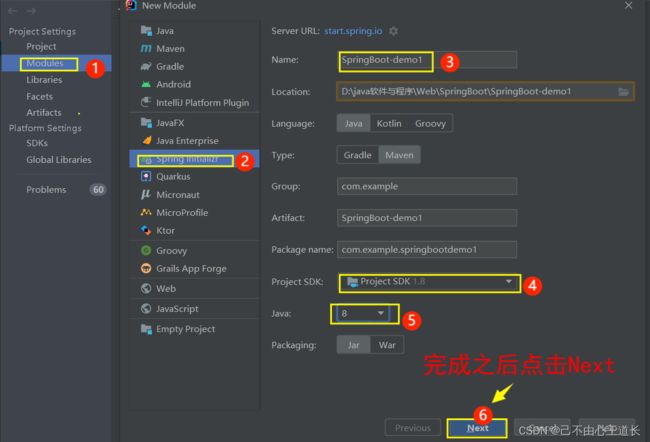
在上面点击Next之后,跳到下面图片
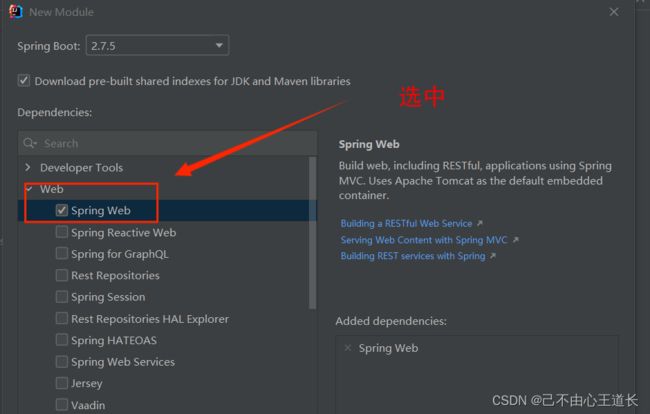
选中之后点击finish—>apply—>ok即可
三、编写测试程序
在Application尝试输出一段话,检查一下代码系统是否正确:
package com.example.springbootdemo1;
import org.springframework.boot.SpringApplication;
import org.springframework.boot.autoconfigure.SpringBootApplication;
@SpringBootApplication
public class SpringBootDemo1Application {
public static void main(String[] args) {
SpringApplication.run(SpringBootDemo1Application.class, args);
System.out.println("鸡到底美不美?");
}
}
SpringBoot配置文件详解
属性配置
一、 我们可以看到,SpringBoot项目下的Resources目录下有一个application.properties的配置文件,SpringBoot通过配置文件application.properties就可以修改默认的配置,什么意思呢?举个例子,因为SpringBoot采用的是内嵌tomcat的方式,所以默认端口是8080,我现在通过application.properties配置文件把8080修改为8081:
server.port=8081
执行测试:可以看到端口号已经由8080变为8081

上述例子说明了application.properties配置文件可以更改SpringBoot提供的默认配置,设置成我们实际需要的配置。
配置文件分类
SpringBoot使用一个全局的配置文件,配置文件名是固定的(都必须是application.开头),支持三种格式(properties、yaml、yml),由于properties类型的我们已经用过很多,这里就不再过多赘述,这里介绍一下yaml或者yml。
一、创建application.yaml、application.yml文件
yml:

yaml:
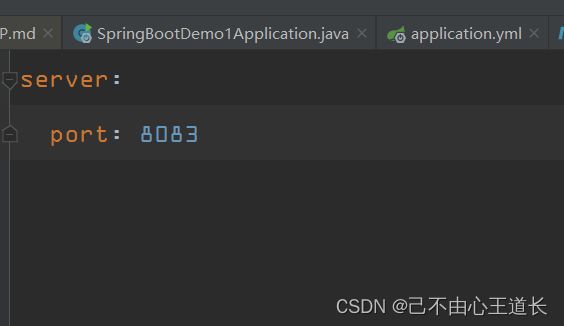
可以看到两者的用法和格式完全一样,那么是不是说两个作用一样呢?答案是两者一样,所以在使用过程中,我们一般选择yml格式
二、yml、yaml的注意点
1、以空格的缩进来控制层级关系,左对齐的一列数据,属于同一个层级
2、yaml、yml 格式:k: v,之间的空格必须有
3、k 和 v 对大小写敏感
4、k: v,字符串默认不用加上单引号或者双引号
5、在这两个配置文件中#表示注释
三、yml中各种数据类型的使用
对象、map类:
普通写法:
Practitioner:
name: kunkun
age: 3
行内写法:
Practitioner: {name: kunkun,age: 3}
数组:
普通写法:
#缩略格式
Practitioner:
- name: kunkun
age:3
likes:
- sing
- dance
- rap
- basketball
- name: xiaoheizi
age: 4
likes:
- kunkun
- zhenxiatou
- suzhi666
行内写法:
Practitioner: [{name: kunkun,age: 3,hobby: [sing,dance,rap,basketball]},
{name: xiaoheizi,age: 4,hobby: [kunkun,zhenxiatou,suzhi666]}]
四、配置文件读取
1、读取单个数据
package com.example.springbootdemo1.controller;
import org.springframework.beans.factory.annotation.Value;
import org.springframework.web.bind.annotation.RequestMapping;
import org.springframework.web.bind.annotation.ResponseBody;
import org.springframework.web.bind.annotation.RestController;
import org.springframework.web.servlet.ModelAndView;
/**
* @author 不止于梦想
* @date 2022/10/21 21:12
*/
@RestController
public class indexController {
@Value("${name}")
public String username;
@ResponseBody
@RequestMapping("/index")
public String welcomeView(){
ModelAndView mv = new ModelAndView();
mv.addObject("user",username);
System.out.println(username);
return "hello";
}
}
//配置文件
name: kunkun
注意:这里踩一个坑,我们在写配置文件的时候,一般都是key value键值对的,而key的值除非是你想要的,不然不要写成user,写成user系统会自动赋值为你系统的管理员:
#这里尝试验证
user:
name: kunkun
package com.example.springbootdemo1.controller;
import org.springframework.beans.factory.annotation.Autowired;
import org.springframework.beans.factory.annotation.Value;
import org.springframework.stereotype.Controller;
import org.springframework.web.bind.annotation.RequestMapping;
import org.springframework.web.bind.annotation.ResponseBody;
import org.springframework.web.bind.annotation.RestController;
import org.springframework.web.servlet.ModelAndView;
/**
* @author 不止于梦想
* @date 2022/10/21 21:12
*/
@Controller
public class indexController {
@Value("${user.name}")
public String username;
@ResponseBody
@RequestMapping("/index")
public String welcomeView(){
ModelAndView mv = new ModelAndView();
mv.addObject("user",username);
System.out.println(username.toString());
return "hello";
}
}
2、读取全部数据
提问:读取全部数据是使用@value标签给所有属性都注入值?
从上面我们可以看到,如果配置文件里的值是少量的,那么可以用@value标签给需要的属性赋值,但是在我们的日常开发中,配置文件的内容很多,一个一个注入得把我们累死!
解决方案:SpringBoot提供了一个对象,能够把所有的数据都封装到这一个对象中,这个对象叫做Environment,使用自动装配注解可以将所有的yaml数据封装到这个对象中
3、读取对象数据
因为Java是一个面向对象的语言,很多情况下,我们会将一组数据封装成一个对象。SpringBoot也提供了可以将一组yml对象数据封装一个Java对象的操作:
第一步:编写配置文件
student:
username: kunkun
age: 3
hobby: dance
第二步:编写一个对象类,并且将该对象类作为bean注入到Spring容器中,然后使用注解@ConfigurationProperties指定该对象加载哪一组yaml中配置的信息。
package com.example.springbootdemo1.pojo;
import org.springframework.boot.context.properties.ConfigurationProperties;
import org.springframework.stereotype.Component;
@Component//交给Spring容器保管
@ConfigurationProperties(prefix = "student")//对应的application.yml配置文件的位置
public class Student{
private String username;
private int age;
private String hobby;
@Override
public String toString() {
return "Student{" +
"username='" + username + '\'' +
", age=" + age +
", hobby='" + hobby + '\'' +
'}';
}
public String getUsername() {
return username;
}
public void setUsername(String username) {
this.username = username;
}
public int getAge() {
return age;
}
public void setAge(int age) {
this.age = age;
}
public String getHobby() {
return hobby;
}
public void setHobby(String hobby) {
this.hobby = hobby;
}
public Student() {
}
public Student(String username, int age, String hobby) {
this.username = username;
this.age = age;
this.hobby = hobby;
}
}
第三步,编写测试类
package com.example.springbootdemo1;
import com.example.springbootdemo1.pojo.Student;
import org.junit.jupiter.api.Test;
import org.junit.runner.RunWith;
import org.springframework.beans.factory.annotation.Autowired;
import org.springframework.boot.test.context.SpringBootTest;
import org.springframework.test.context.junit4.SpringRunner;
@RunWith(SpringRunner.class)
@SpringBootTest
class SpringBootDemo1ApplicationTests {
@Autowired
private Student student;
@Test
void contextLoads() {
System.out.println(student);
}
}
总结:@value和@ConfigurationProperties都是获取配置文件信息的;@value常用在获取单个或者少量的配置文件,而后者常需要对应配置文件属性的封装类,即把文件属性映射写成一个封装的类,并把类交给spring管理(常配合Component使用)。然后使用@ConfigurationProperties添加前缀以对应起来配置文件的属性。
SpringBoot整合Thymeleaf模板引擎
Thymeleaf简介
一、Thymeleaf是一个流行的模板引擎,该模板引擎采用Java语言开发,模板引擎是一个技术名词,是跨领域跨平台的概念,在Java语言体系下有模板引擎,在C#、PHP语言体系下也有模板引擎。除了thymeleaf之外还有Velocity、FreeMarker等模板引擎,功能类似
二、Thymeleaf的主要目标是将优雅的自然模板带到您的开发工作流程中—HTML能够在浏览器中正确显示,并且可以作为静态原型,从而在开发团队中实现更强大的协作。Thymeleaf能够处理HTML,XML,JavaScript,CSS甚至纯文本。
三、Thymeleaf的主要目标是提供一个优雅和高度可维护的创建模板的方式。 为了实现这一点,它建立在自然模板的概念之上,以不影响模板作为设计原型的方式将其逻辑注入到模板文件中。 这改善了设计沟通,弥合了前端设计和开发人员之间的理解偏差。
示例:Thymeleaf 通过在 html 标签中,增加额外属性来达到“模板+数据”的展示方式,示例代码如下。
DOCTYPE html>
<html lang="en" xmlns:th="http://www.thymeleaf.org">
<head>
<meta charset="UTF-8">
<title>Titletitle>
head>
<body>
<h1 th:text="欢迎来到Thymeleaf">欢迎访问静态页面h1>
body>
html>
当直接使用浏览器打开时,浏览器展示结果如下。
欢迎来到Thymeleaf
当通过 Web 应用程序访问时,浏览器展示结果如下。
欢迎访问静态页面
整合
SpringBoot整合Thymeleaf需要三个步骤:
一、引入对应Thymeleaf的starter,其实在以后的整合中,要整合什么技术,就引入该技术的starter即可:
<!-- https://mvnrepository.com/artifact/org.springframework.boot/spring-boot-starter-thymeleaf -->
<dependency>
<groupId>org.springframework.boot</groupId>
<artifactId>spring-boot-starter-thymeleaf</artifactId>
<version>2.7.3</version>
</dependency>
二、创建模板文件,并放在指定目录下
2.1 由于 SpringBoot 为 thymeleaf 提供了一整套的自动化配置方案,我们几乎不用做任何更改就可以直接使用,如下是SpringBoot中thymeleaf的默认配置
@ConfigurationProperties(prefix = "spring.thymeleaf")
public class ThymeleafProperties {
private static final Charset DEFAULT_ENCODING = StandardCharsets.UTF_8;
public static final String DEFAULT_PREFIX = "classpath:/templates/";
public static final String DEFAULT_SUFFIX = ".html";
/**
* Whether to check that the template exists before rendering it.
*/
private boolean checkTemplate = true;
/**
* Whether to check that the templates location exists.
*/
private boolean checkTemplateLocation = true;
/**
* Prefix that gets prepended to view names when building a URL.
*/
private String prefix = DEFAULT_PREFIX;
/**
* Suffix that gets appended to view names when building a URL.
*/
private String suffix = DEFAULT_SUFFIX;
/**
* Template mode to be applied to templates. See also Thymeleaf's TemplateMode enum.
*/
private String mode = "HTML";
...
}
通过 org.springframework.boot.autoconfigure.thymeleaf.ThymeleafProperties 找到 SpringBoot 中 thymeleaf 的默认配置:
@ConfigurationProperties //这个注解熟不熟悉,这不就是上面的读取配置文件注入的注解吗? DEFAULT_ENCODING :默认字符编码,为utf-8 DEFAULT_PREFIX 默认前缀表达式,值为"classpath:/templates/",即类路径下的templates,对应了SpringBoot项目下的Resource下的templates。 DEFAULT_SUFFIX 后缀表达式,默认为.html
从上面代码可以看出,thymeleaf 模板文件默认放在 resources/templates 目录下,默认的后缀是 .html。
当然,我们有时候不想用默认配置,因为需求是多样的,这个时候SpringBoot也是提供了个性化的方法供我们使用。;
在SpringBoot配置文件中:
spring:
#thymeleaf模板引擎
thymeleaf:
#是否开启缓存
cache: false
#编码格式
encoding: UTF-8
这里我把缓存关闭,就能使页面进行实时的更新。
三、整合thymeleaf 模板引擎
上面已经把starter导入了,然后配置了thymeleaf,接下来编写测试
编写一个Controller:
package com.example.springbootdemo1.controller;
import com.example.springbootdemo1.pojo.User;
import org.springframework.web.bind.annotation.RequestMapping;
import org.springframework.web.bind.annotation.RestController;
import org.springframework.web.servlet.ModelAndView;
import java.util.ArrayList;
import java.util.List;
/**
* @author 不止于梦想
* @date 2022/10/21 21:12
*/
@RestController
public class indexController {
@RequestMapping("/index")
public ModelAndView indexView(){
ModelAndView mv = new ModelAndView();
List<User> userList = new ArrayList<>();
for(int i=0;i<5;i++){
User user = new User("zhangsan"+i,5+i);
userList.add(user);
}
mv.addObject("user",userList);
mv.setViewName("index");
return mv;
}
}
编写要跳转的index.html界面
<!DOCTYPE html>
<html lang="en" xmlns:th="http://www.thymeleaf.org"><!--引入thymeleaf命名空间-->
<head>
<meta charset="UTF-8">
<title>Title</title>74
</head>
<body>
<table border="1">
<tr>
<td>用户姓名</td>
<td>用户年龄</td>
</tr>
<tr th:each="item : ${userList}">
<td th:text="${item.userName}"></td>
<td th:text="${item.userAge}"></td>
</tr>
</table>
</body>
</html>
在配置文件中,编写视图解析器:
spring:
#thymeleaf模板引擎
thymeleaf:
#是否开启缓存
cache: false
#编码格式
encoding: UTF-8
mvc:
view:
prefix: /pages/
suffix: .html
总结
SpringBoot是一门十分重要的技术,而学习这门技术有一定的门槛,需要我们掌握Spring技术栈的相关东西,而Spring Boot对于后面分布式的服务又是至关重要的,SpringCloud是在Spring Boot基础之上才能加以学习的,所以每一个Java技术人员,都应该学好SpringBoot。




